/cloudfront-us-east-1.images.arcpublishing.com/octane/WUESWWDAUPLBJWR2Y53EEJ3CGE.jpg)
Loose, tight, or worn steering-head bearings are going to impact your bike's handling—and not in a good way. Thankfully, checking and adjusting steering-head bearings is pretty easy. Here's how to do it.
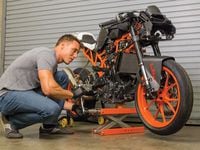
With the bike's bodywork removed, jack the front wheel up. Use your bike's centerstand or a rearstand to stabilize the bike, and then lift the front up with a scissor jack or a floor jack. Whatever method you use, make sure it's stable!Brian MacLean
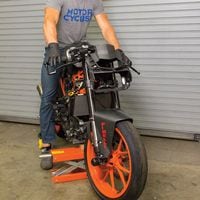
Swing the steering slowly from side to side. It should feel smooth. If the steering binds or if you feel any notchiness (usually with the bars dead ahead), that's a sign your bearings are worn.Brian MacLean

Now kneel in front of the bike and grab the fork about midway up and gently push and pull, front to back. If the bearings are loose you'll feel play or maybe even hear a clunk or click.Brian MacLean
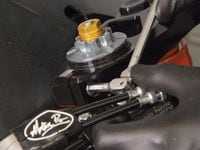
To adjust the bearings, first loosen the upper fork pinch bolts and the top-triple nut or bolt, and then turn the adjustment collar that's beneath the top triple clamp. Use a drift and a hammer or a shock-spring spanner to turn the collar.Brian MacLean
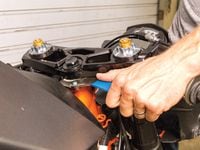
If your bearings were loose, add 1/8 turn of preload at a time until the play is taken out. If the bearings were tight, do the opposite. You want the bearings to be tight enough that there's no play but not so tight that there's drag.Brian MacLean
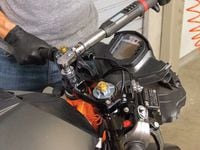
Once you've reached that sweet spot of no play and minimal drag, tighten the top triple nut or bolt then torque the upper pinch bolts. Make sure you tighten everything to the proper torque and you're all set.Brian MacLean
/cloudfront-us-east-1.images.arcpublishing.com/octane/IN263JIBTBCD3O265IMSCW6OZM.jpg)
/cloudfront-us-east-1.images.arcpublishing.com/octane/SMAQ354X2JH7NJATXNSQY4NRS4.jpg)
/cloudfront-us-east-1.images.arcpublishing.com/octane/GGOH2AQRSVHY5C5JLNEVYLB5SU.jpg)
/cloudfront-us-east-1.images.arcpublishing.com/octane/TJJEHV3ATZFFXHUYZABHXKE2DI.jpg)
/cloudfront-us-east-1.images.arcpublishing.com/octane/WIC4RXQ36BAXNIW6U4UJ3XDLKI.jpg)
/cloudfront-us-east-1.images.arcpublishing.com/octane/B4PQZLY4LBHITGE5ZRRM2N5YNU.jpg)
/cloudfront-us-east-1.images.arcpublishing.com/octane/OBYS7KWZUJFCHD44YPTSVM5EF4.jpg)
/cloudfront-us-east-1.images.arcpublishing.com/octane/FY7ZXYBT4NH2NGYQIWQVITS4AM.jpg)
/cloudfront-us-east-1.images.arcpublishing.com/octane/JPET6WQUDZEYLNXVY5LRNDRPLA.jpg)
/cloudfront-us-east-1.images.arcpublishing.com/octane/EY6P2QIFQJCDTNOMR3JB7WJED4.jpg)
/cloudfront-us-east-1.images.arcpublishing.com/octane/V2U6JB7KXNCQRN4OW6HNJTVMZQ.jpg)
/cloudfront-us-east-1.images.arcpublishing.com/octane/AMS43BT5ABH77NY7XKLCSZCNM4.jpg)
/cloudfront-us-east-1.images.arcpublishing.com/octane/NTK2ASYKUBDW5MQDWQLVQYOELY.jpg)
/cloudfront-us-east-1.images.arcpublishing.com/octane/SX7R3KCIANGDBGF45O73F543TM.jpg)
/cloudfront-us-east-1.images.arcpublishing.com/octane/ZTW4V7RAPFG6RFWJRXR2IX5ZQ4.jpg)
/cloudfront-us-east-1.images.arcpublishing.com/octane/EPRSLPIUTBC5RPD7R263BPV2D4.jpg)
/cloudfront-us-east-1.images.arcpublishing.com/octane/EMJ4I2T4HVCRVJPZ3UJFVMRDHA.jpg)
/cloudfront-us-east-1.images.arcpublishing.com/octane/CBDAM3VMJNFDBLE7Y3FY7RD5BY.jpg)
/cloudfront-us-east-1.images.arcpublishing.com/octane/CCEB3TNMU5FH3OZ4FKJ7DA2LBA.jpg)
/cloudfront-us-east-1.images.arcpublishing.com/octane/VV6N3KUWEVFJJD7F7VX6ICOH7Q.jpg)
/cloudfront-us-east-1.images.arcpublishing.com/octane/R55SVEXZ5VA2LCWFWYR647ASX4.jpg)
/cloudfront-us-east-1.images.arcpublishing.com/octane/MYWIEFOQ6JCCNDR4OBF5PU5LVE.jpg)
/cloudfront-us-east-1.images.arcpublishing.com/octane/OOZ3C4GCUJGRNONDI6DHVM57GI.jpg)
/cloudfront-us-east-1.images.arcpublishing.com/octane/JEKB3CMWXZD6ZAVFEDKLOQ5FNY.jpg)